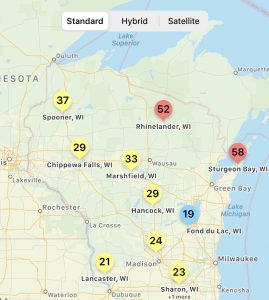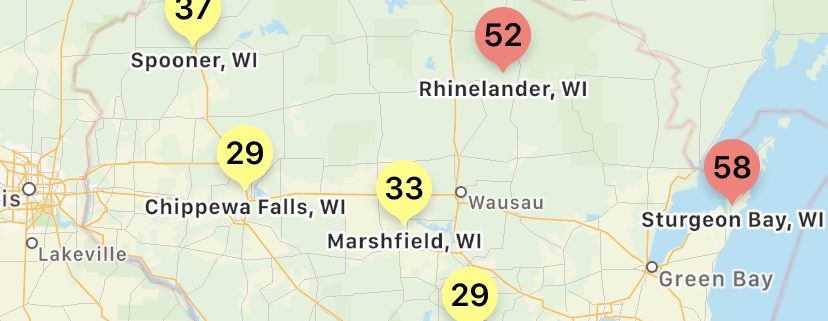Wisconsin Soybean White Mold Update – July 29, 2020
Damon Smith, Extension Field Crops Pathologist, Department of Plant Pathology, University of Wisconsin-Madison
Shawn Conley, Extension Soybean and Small Grains Agronomist, Department of Agronomy, University of Wisconsin-Madison
Roger Schmidt, Nutrient and Pest Management Program, University of Wisconsin-Madison

Figure 1. Sporecaster predictions for selected non-irrigated locations in Wisconsin for July 29, 2020.
Figure 1 illustrates the calculated risk of white mold for select Wisconsin locations for non-irrigated soybeans, as determined by Sporecaster for July 29, 2020. This means that if soybeans are flowering and the area between rows is filled in more than 50%, risk is just moderate in most locations of the state, with the exception of the far northeast portions of the state and Door County. This moderate risk indicates that there may not be apothecia present in fields in these locations at this time, with reduced risk of subsequent white mold development due to hot and dry conditions. Remember that this season, you have the ability to change the action threshold for each field in the app. Last season the action threshold was locked at 40%, which is still a reasonable threshold for Wisconsin. Thus, figure 1 risk is calculated based on 40%. You can tailor this threshold to your liking based on your prior knowledge of a field, or your acceptable risk level. Further tailored predictions for irrigated locations and locations planted to narrower row-spacing can be run by downloading the Sporecaster app to your smartphone.
As we move toward the end of the fungicide spray window at R3, a fungicide application might not be warranted at this time on non-irrigated fields. In irrigated fields, we are seeing higher risk and finding apothecia in irrigated fields in central locations. A fungicide spray might be warranted in this situation.
I’m Ready To Spray, What Should I use?
If the canopy has met threshold, soybeans are flowering, and your Sporecaster risk is high, then a fungicide might be warranted. If you have decided to spray soybeans for white mold, what are the best products to use? I have written extensively about this in a previous post which you can find HERE. Over the last several years we have run numerous fungicide efficacy trials in Wisconsin and in conjunction with researchers in other states. In Wisconsin, we have observed that Endura applied at 8 oz once between the R1 and R3 growth stages performs well. We have also observed that the fungicide Aproach applied at 9 fl oz at R1 and again at R3 also performs comparably to the Endura treatment. Other fungicide options also include Omega and Proline. You can view results of past fungicide evaluations for Wisconsin by CLICKING HERE. If you would like to run tailored estimations of return on investment for various fungicide programs, you can use another smartphone application called Sporebuster.
Helpful Smartphone Application Links
Sporecaster
- Click here to download the Android version of Sporecaster.
- Click here to download the iPhone version of Sporecaster.
- Here is a helpful video if you would like some tips on how to use Sporecaster.
Sporebuster
- Click here to download the Android version of Sporebuster.
- Click here to download the iPhone version of Sporebuster.
- Here is a video on how to use Sporebuster and interpret the output.
Other White Mold Resources
- To watch an in-depth video on white mold management, CLICK HERE.
- To find more information and download a fact sheet on white mold from the Crop Protection Network, CLICK HERE.





